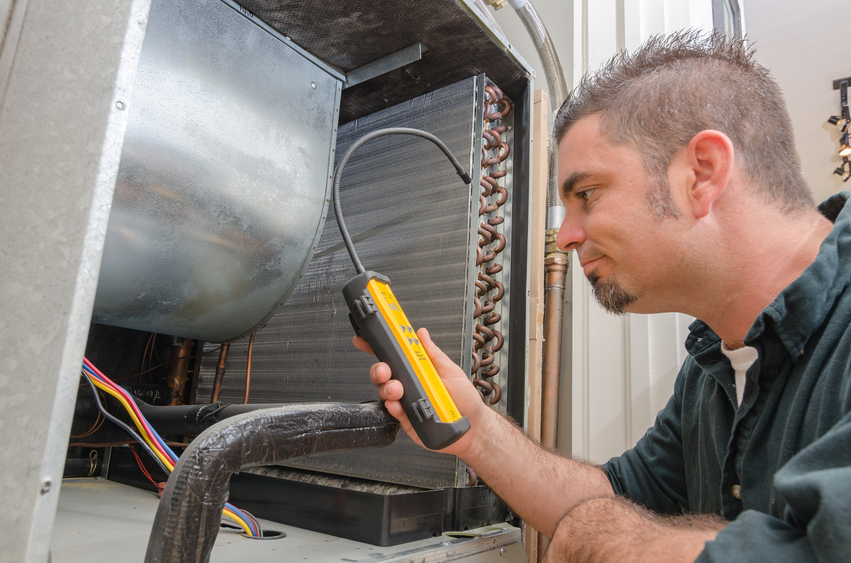Do you use refrigerants in your day-to-day facility operations? Can you reduce your compliance exposure when it comes to refrigerant leaks? Yesterday we took a look at how your local supermarket may be reducing refrigerant emissions. Today we will explore some suggestions for reducing the potential for a refrigerant leak.
 |
It’s always good to know what to do when there is a refrigerant leak at your facility. But wouldn’t it be better to reduce the potential that a leak will even happen? Through a program called GreenChill, the U.S. Environmental Protection Agency (EPA) partners with supermarkets nationwide to reduce refrigerant emissions. GreenChill has developed some guidance documents related to refrigerant management. Let’s look at some of the suggestions for reducing the potential for refrigerant leaks at supermarkets. Maybe some of them can work for you, too.
In addition to all the necessary good housekeeping and maintenance practices and requirements for your refrigerant system, GreenChill provides some steps you can take to reduce the potential for a refrigerant leak to happen in the first place.
Monitor the ‘Winter Charge’
A refrigeration system may require a “winter charge,” in which more refrigerant is used in the winter to permit flooding of the condenser to maintain a minimum operating system head pressure. This charge should be kept as small as possible by using split-condenser valves, fan cycling, and floating head pressure control. This total annual charge may only be needed for a few hours a year and is stored the rest of the time in the system’s receiver. As a result, a system could have an excess refrigerant charge in the receiver over 90% of the time.
If a leak occurs during this 90% period, you could lose the entire receiver charge before the refrigerant loss begins to affect case temperatures. To minimize the potential for such loss:
- Document the receiver levels during winter and summer conditions as well as when the system is in defrost or heat recovery mode.
- Post these levels on the refrigeration rack or in some other convenient location that is readily available to any service tech who would be charging the system after a leak.
- It is common practice for service technicians to charge additional refrigerant to a system as a safety buffer. This buffer refrigerant will add to the potential loss. It is a good idea to institute a policy to avoid this practice.
Upgrade System Components
System components should be replaced with parts that are more leak-resistant or that have a reduced number of potential leak sources. For example, discharge-piloted evaporator pressure regulating valves may be replaced with suction stepper valves, which eliminate the high-side control line, provide better temperature control, and are generally more reliable.
During major remodels, you may also want to consider replacing centralized systems with distributed systems, secondary loop systems, or carbon dioxide (CO2) systems to further reduce leak potential. Refrigeration systems that use CO2 as a primary refrigerant are commonly referred to as transcritical CO2 systems. Transcritical CO2 refrigeration is a type of refrigeration cycle in which CO2 is the sole refrigerant, evaporating in the subcritical region and rejecting heat at temperatures above the critical point in a gas cooler instead of a condenser.
General Recommendations
Recommendations for reducing leak potential in an existing refrigerant system include:
- Replacing flared connection components with brazed connection components.
- Replacing valves with bolted connections with hermetic one-piece valves with no mechanical joints.
- Replacing valves with control lines with valves that don’t require control lines.
- Ensuring the proper cap is in place on all valve stems designed to be capped, as well as access Schrader valves. The caps should also have the proper seal or O-ring in place to ensure leak tightness.
- Replacing fragile cap tube-type control lines with steel lines or armored flexible lines.
- Tightening bolts on flanges used to connect valves and filter-drier covers to the proper torque and using a new gasket in reassembly.
- Eliminating liquid hammer (when steam and condensation water combine and meet with an obstacle, such as a valve or cap) by mounting a sealed vertical tee ahead of the solenoid valve (i.e., a valve controlled by an electric current and used to control the flow of liquids and gases).
- Using an approved thread sealant to prevent leakage from threads or from corrosion around threads.
- Protecting tubing by creating a space separation or using a cushioning material.
- Ensuring equipment located in vulnerable environments has epoxy or phenolic coatings on fin-tube surfaces, refrigerant piping, or other components that are subject to corrosion. Vulnerable equipment may include service deli cases that are in contact with vinegar-containing products and rooftop condensers that are located near the coastline or a chemical plant.
- Ensuring chemical compatibility of cleaning agents with components and materials.
Refrigerants are used in a number of industries, and the EPA is cracking down on the use of those considered harmful to public health and the environment. Keep track of EPA’s efforts with 24/7 access to Enviro.BLR.com®.
